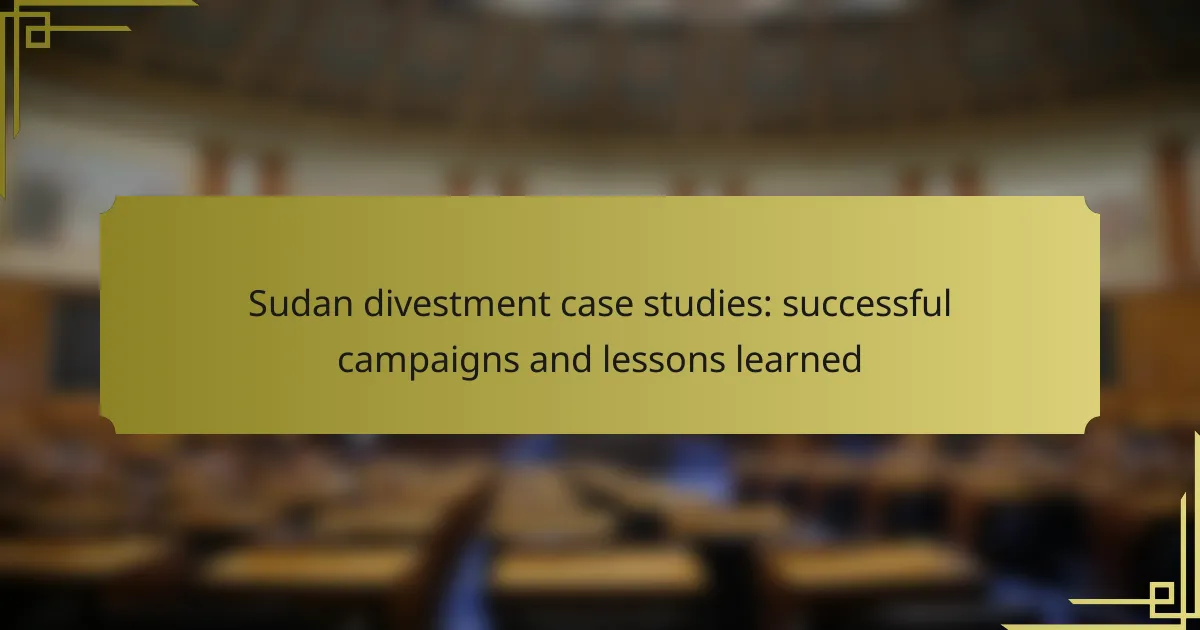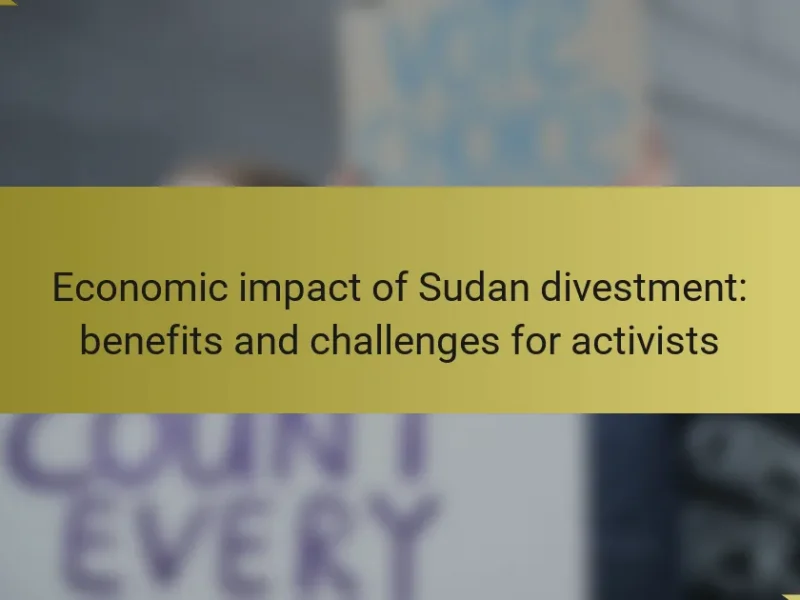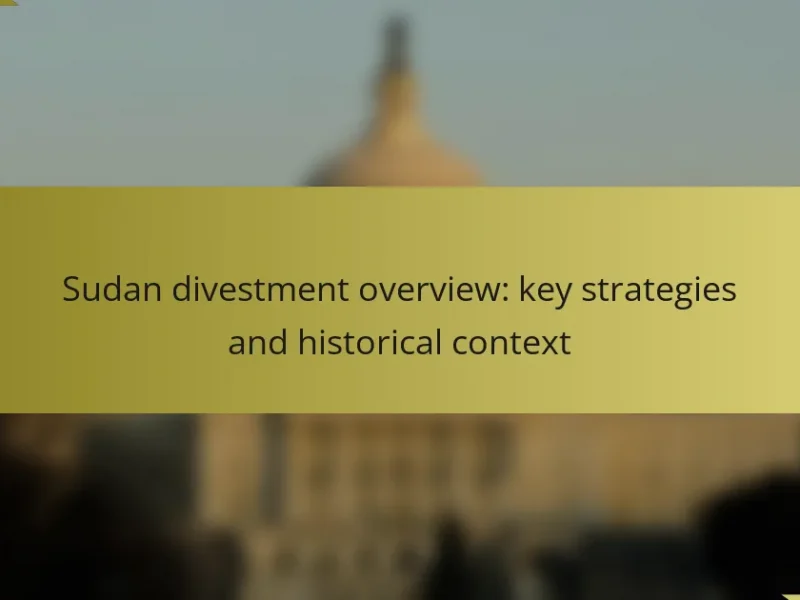The Sudan divestment case studies focus on three key components: financial divestment, advocacy efforts, and legislative actions. Financial divestment involves withdrawing investments from companies operating in Sudan, while advocacy efforts include grassroots campaigns aimed at raising awareness of the humanitarian crisis. Legislative actions consist of government measures enforcing divestment policies to pressure the Sudanese government to cease human rights abuses. The article outlines critical lessons learned from these case studies, emphasizing the effectiveness of coordinated grassroots campaigns, the importance of transparency in investment practices, and the role of academic research. Additionally, it highlights the significant impact of social media in mobilizing public opinion and the necessity of sustained advocacy for long-term change. Stakeholders can apply insights from these case studies to enhance future divestment strategies through informed decision-making and community engagement.

What are the key components of the Sudan divestment case studies?
The key components of the Sudan divestment case studies include financial divestment, advocacy efforts, and legislative actions. Financial divestment refers to the withdrawal of investments from companies operating in Sudan. Advocacy efforts involve grassroots campaigns that raise awareness about the humanitarian crisis in Sudan. Legislative actions are government measures aimed at enforcing divestment policies. Collectively, these components aimed to pressure the Sudanese government to end human rights abuses. For example, universities and institutions across the U.S. adopted divestment policies in response to the genocide in Darfur. These actions demonstrated the power of coordinated efforts in influencing corporate and governmental policies.
How have successful campaigns been defined in the context of Sudan divestment?
Successful campaigns in the context of Sudan divestment are defined by their ability to effectively mobilize public support and influence institutional investors. These campaigns often utilize strategic messaging and grassroots organizing to raise awareness about the humanitarian crisis in Sudan. They aim to persuade universities, pension funds, and other entities to withdraw investments from companies operating in Sudan. A key measure of success is the amount of divested funds, which can reach billions as seen in campaigns led by organizations like Divest for Peace. Additionally, successful campaigns often result in policy changes and increased pressure on the Sudanese government to address human rights violations. The effectiveness of these campaigns is also evidenced by the growing number of institutions committing to divestment, indicating a shift in corporate responsibility and ethical investment practices.
What criteria were used to evaluate the success of these campaigns?
The criteria used to evaluate the success of the Sudan divestment campaigns included financial impact, public awareness, and policy changes. Financial impact measured the amount of divestment achieved from companies operating in Sudan. Public awareness assessed the level of engagement and understanding among the general populace regarding the issues in Sudan. Policy changes evaluated the legislative actions taken by governments or institutions in response to the campaigns. These criteria provided a comprehensive framework for assessing the overall effectiveness of the campaigns.
What specific goals did these campaigns aim to achieve?
The campaigns aimed to achieve economic pressure on the Sudanese government. They sought to compel a change in policies regarding human rights abuses. The campaigns also aimed to raise public awareness about the situation in Sudan. Additionally, they intended to mobilize grassroots support for divestment initiatives. The ultimate goal was to contribute to the end of violence and oppression in the region. Evidence of success includes significant divestment from companies operating in Sudan. This divestment led to financial losses for the Sudanese government. The campaigns were effective in influencing institutional investors to reconsider their investments.
What strategies were employed in successful Sudan divestment campaigns?
Successful Sudan divestment campaigns employed several key strategies. These included grassroots mobilization to raise awareness about the issues in Sudan. Campaigns often utilized targeted messaging to resonate with specific audiences. Engaging influential stakeholders, such as universities and pension funds, was crucial for driving divestment decisions. Public pressure through protests and petitions helped to amplify the message. Transparency in reporting the impacts of investments in Sudan increased accountability. Collaborations with advocacy groups strengthened the movement’s reach and effectiveness. Research studies provided evidence of human rights abuses, supporting the case for divestment. These strategies collectively contributed to the success of the campaigns.
How did grassroots movements contribute to these strategies?
Grassroots movements significantly contributed to divestment strategies in Sudan by mobilizing public opinion. They raised awareness about the humanitarian crisis in Darfur, leading to widespread support for divestment. Campaigns like “Divest Sudan” effectively engaged communities through education and advocacy. Activists organized protests and events to pressure institutions to withdraw investments from companies operating in Sudan. This grassroots pressure influenced lawmakers to consider divestment legislation. For example, California’s divestment law was a direct response to grassroots advocacy. Additionally, these movements created a network of solidarity that amplified their message globally. Their efforts resulted in billions of dollars in divestments, impacting the Sudanese government financially.
What role did international organizations play in these campaigns?
International organizations played a crucial role in the Sudan divestment campaigns. They provided essential support by raising awareness about the humanitarian crisis in Sudan. Organizations like the United Nations and Amnesty International documented human rights abuses. Their reports helped mobilize public opinion and influenced policymakers. Additionally, these organizations coordinated efforts among various stakeholders. They facilitated partnerships between governments, NGOs, and the private sector. This collaboration amplified the impact of divestment initiatives. Furthermore, international organizations offered platforms for dialogue and advocacy. Their involvement was pivotal in sustaining momentum for divestment actions.

What lessons have been learned from Sudan divestment case studies?
Sudan divestment case studies reveal critical lessons for future advocacy and investment strategies. One lesson is the effectiveness of coordinated grassroots campaigns. These campaigns mobilized public opinion and pressured institutions to divest. Another lesson is the importance of transparency in investment practices. Clear communication about divestment goals helps build trust with stakeholders. Case studies also highlight the role of academic research in informing divestment decisions. Research provides credible evidence to support claims against unethical practices. Additionally, the impact of social media as a tool for awareness and mobilization has been significant. It allows for rapid dissemination of information and engagement. Lastly, sustained pressure is necessary for long-term change. Continuous advocacy keeps the issue in the public eye and maintains momentum for divestment efforts.
What challenges did campaigns face during the divestment process?
Campaigns faced significant challenges during the divestment process. One major challenge was the resistance from financial institutions. Many institutions were reluctant to divest due to concerns about profitability and market stability. Another challenge was the lack of awareness among stakeholders about the implications of investing in Sudan. This made it difficult to mobilize support for divestment efforts. Additionally, campaigns struggled with the complexity of legal frameworks surrounding divestment. Navigating these regulations often required substantial legal expertise. Furthermore, campaigns faced internal divisions among activist groups, which sometimes hindered unified action. Lastly, the political landscape was often unfavorable, with varying levels of government support for divestment initiatives. These factors collectively complicated the divestment process significantly.
How did these challenges impact the overall effectiveness of the campaigns?
The challenges significantly reduced the overall effectiveness of the campaigns. Limited resources hindered outreach and engagement efforts. This resulted in a smaller audience reach and less public awareness. Complicated political landscapes created obstacles in forming coalitions. Consequently, campaigns struggled to maintain momentum and unify supporters. Additionally, misinformation undermined credibility and trust. As a result, the campaigns faced difficulties in achieving their goals. Overall, these challenges led to diminished impact and effectiveness in advocating for divestment.
What were the common obstacles encountered by activists?
Activists commonly encountered obstacles such as governmental repression, lack of funding, and public apathy. Governmental repression included arrests and harassment of activists, which stifled their efforts. Lack of funding limited their ability to organize and promote campaigns effectively. Public apathy made it challenging to mobilize support for their causes. Additionally, misinformation spread by opposing groups created confusion among the public. These obstacles hindered the overall impact of their campaigns. The challenges faced by activists in the Sudan divestment movement illustrate the complexities of advocacy work.
What best practices emerged from successful campaigns?
Successful campaigns in the Sudan divestment movement highlighted several best practices. Clear messaging was essential for mobilizing support. Campaigns effectively communicated the urgency of the crisis in Sudan. Building coalitions with diverse groups strengthened advocacy efforts. Collaboration amplified the reach and impact of the campaigns. Grassroots organizing engaged local communities and raised awareness. Utilizing social media expanded outreach and facilitated real-time communication. Tracking and reporting progress maintained transparency and accountability. These practices contributed to the overall success of the divestment initiatives.
How can these best practices be applied to future divestment efforts?
Best practices from previous divestment efforts can be applied to future campaigns by ensuring thorough research and stakeholder engagement. Conducting comprehensive analysis helps identify effective strategies and potential obstacles. Engaging stakeholders fosters collaboration and builds support for divestment initiatives. Clear communication of goals and outcomes is essential to maintain transparency. Utilizing social media and public campaigns can raise awareness and mobilize support. Monitoring and evaluating the impact of divestment actions allows for adjustments and improvements. Historical examples, such as the divestment from South Africa during apartheid, demonstrate the effectiveness of these approaches. This evidence supports the application of these best practices in future divestment efforts.
What innovative approaches were utilized to overcome challenges?
Innovative approaches utilized in the Sudan divestment case studies included grassroots mobilization and strategic partnerships. Grassroots mobilization involved engaging local communities to raise awareness and support for divestment efforts. This approach empowered individuals to advocate for change, increasing public pressure on companies. Strategic partnerships with NGOs and advocacy groups amplified the campaign’s reach and effectiveness. Collaborations provided resources and expertise, enhancing the overall impact of divestment initiatives. These methods successfully created a unified front against investments in Sudan, demonstrating the power of collective action and strategic alliances.

How can stakeholders apply insights from Sudan divestment case studies?
Stakeholders can apply insights from Sudan divestment case studies by adopting strategic divestment practices. These practices involve analyzing the effectiveness of previous divestment campaigns. For example, stakeholders can learn from the coordinated efforts that led to significant financial pressure on the Sudanese government. Historical data shows that divestment campaigns resulted in a reduction of foreign investment in Sudan. Stakeholders can also assess the role of public awareness in influencing corporate behavior. Engaging communities and leveraging media campaigns proved vital in previous initiatives. Additionally, stakeholders can utilize metrics from past campaigns to measure impact and success. This approach facilitates informed decision-making and enhances the effectiveness of future divestment strategies.
What actionable steps can organizations take to initiate divestment?
Organizations can initiate divestment by conducting a thorough analysis of their investments. This analysis should identify any financial ties to entities operating in Sudan. Next, organizations should establish clear divestment criteria based on ethical considerations and financial risks. They can then create a divestment plan outlining specific timelines and methods for divesting. Engaging stakeholders is crucial; organizations should communicate the reasons for divestment to investors and the public. Additionally, organizations should monitor and report on the progress of divestment efforts to maintain transparency. Research indicates that divestment can lead to significant financial and reputational impacts on targeted entities, reinforcing the importance of a strategic approach.
How should organizations assess their current investment portfolios?
Organizations should assess their current investment portfolios by analyzing performance metrics and alignment with strategic goals. They need to evaluate returns on investment and risk exposure. Comparing current holdings against benchmarks is essential. Organizations should also consider the ethical implications of their investments. This includes assessing the social and environmental impact of their portfolio. Regular reviews facilitate timely adjustments to improve performance. Utilizing financial analysis tools can enhance decision-making. Data from market trends can provide insights for future investments.
What resources are available to support divestment initiatives?
Divestment initiatives can be supported by various resources. These include financial databases that track investments in targeted sectors. Research organizations provide reports detailing the impact of divestment. Advocacy groups offer toolkits for mobilizing public support. Legal resources help navigate regulatory frameworks. Educational materials raise awareness about the issues at stake. Networking platforms connect activists and organizations involved in divestment. Additionally, case studies highlight successful strategies and outcomes from previous campaigns. These resources collectively empower stakeholders to effectively pursue divestment initiatives.
What are the implications of these case studies for future activism?
The implications of these case studies for future activism include the importance of strategic partnerships and targeted messaging. Successful campaigns demonstrate that collaboration with NGOs and grassroots organizations amplifies impact. They also show that clear, focused objectives resonate more effectively with stakeholders. Furthermore, leveraging social media platforms enhances visibility and mobilizes support. Data-driven approaches, as evidenced by these case studies, allow activists to tailor their strategies for maximum effectiveness. Historical successes indicate that sustained pressure on corporations can lead to significant policy changes. These insights provide a framework for future activism to replicate successful tactics and adapt to evolving challenges.
How can these insights inform broader social justice movements?
Insights from the Sudan divestment case studies can guide broader social justice movements by highlighting effective strategies. These campaigns demonstrate the power of public pressure on corporations and governments. For instance, the divestment movement leveraged consumer activism to influence investment decisions. This approach resulted in significant financial consequences for entities supporting oppressive regimes. Additionally, the case studies reveal the importance of coalition-building among diverse groups. Collaboration enhances visibility and amplifies messages across various platforms. Historical examples show that targeted advocacy can lead to policy changes. The success of these campaigns underscores the need for sustained engagement and awareness. By applying these lessons, social justice movements can create impactful narratives and drive systemic change.
What role does public awareness play in successful divestment campaigns?
Public awareness is crucial for successful divestment campaigns. It mobilizes public support and creates pressure on targeted entities. Increased awareness leads to greater community engagement and activism. Campaigns that effectively communicate their message often achieve better results. For instance, the Sudan divestment movement gained traction through public education efforts. These efforts highlighted the humanitarian crisis in Sudan. As a result, universities and pension funds faced public pressure to divest. Reports show that campaigns with high public visibility tend to attract more media coverage. This media attention further amplifies the campaign’s message and urgency.
What practical tips can organizations use to enhance their divestment efforts?
Organizations can enhance their divestment efforts by developing clear divestment policies. These policies should outline specific criteria for divesting from certain entities. Engaging stakeholders early in the process is crucial. This includes investors, employees, and community members to build support.
Conducting thorough research on the entities involved helps identify risks and ethical concerns. Transparency in communication about divestment goals and progress fosters trust and accountability. Leveraging social media and public campaigns can raise awareness and mobilize public opinion.
Collaboration with other organizations amplifies impact and shares resources. Regularly reviewing and updating divestment strategies ensures they remain effective and relevant. These strategies are supported by successful divestment campaigns, such as those against apartheid in South Africa, which demonstrated the power of collective action.
The main entity of the article is the Sudan divestment case studies, which analyze successful campaigns aimed at pressuring the Sudanese government to address human rights abuses through financial divestment, advocacy efforts, and legislative actions. Key components include the mobilization of public support, strategic messaging, and partnerships with international organizations, all contributing to significant financial impacts and policy changes. The article outlines criteria for evaluating campaign success, challenges faced by activists, and best practices that emerged from these initiatives, providing actionable insights for future divestment efforts and broader social justice movements.


